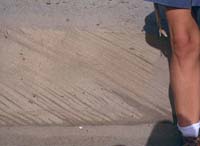Studying Point Bars
As a point bar builds up, coarse grains are deposited near the base of the structure. Finer grains are added as the water flows toward the top of the bar. The distinctive layering and half-ellipse shape are among the features that make point bars easily recognizable, even beneath the surface of the Earth.
Identifying Point Bars Underground
Geologists look for many other signs when building a picture of underground point bar formations. Sedimentary structures such as dunes and ripples are found on the surface of point bars. These unique features form on the surface of the point bar as it grows and are preserved over time as the sediments turn to rock. These structures are aligned by the flow of the current in the river and have a distinct relationship to the point bar.
The Importance of Point Bars
|
Ripples on the surface of a modern point bar indicate the direction of the flow of the water. |
In many parts of the world, oil and gas are found trapped in sands that were deposited as point bars millions of years ago. In order to efficiently drain these reservoirs, geologists need to predict their location deep beneath the surface of the Earth. To do this, they examine data from magnetic, gravity, and seismic surveys. If a possible oil reservoir is found, an exploratory well may be drilled.
Geologists look closely at rock samples that come up from the well, examining the samples for clues to determine the orientation of a point bar and its structures within the well. For example, in cross sections of a point bar, clearly defined layers are visible: the finest particles—silt and clay—are on top and the larger particles—sand and tiny pebbles—are on the bottom. This vertical sequence of grain sizes, characteristic of point bars, enables geologists to recognize these formations in boreholes.
What high-tech tools do geologists use to identify point bars underground?
|
This cross section of a modern point bar shows cross-bedding deposited by large ripples. |
This content has been re-published with permission from SEED. Copyright © 2025 Schlumberger Excellence in Education Development (SEED), Inc.



